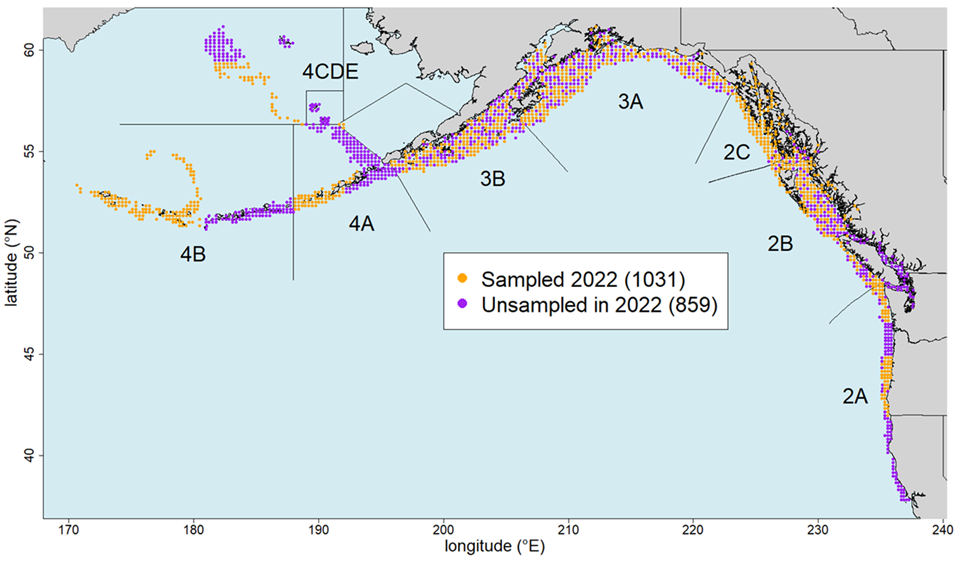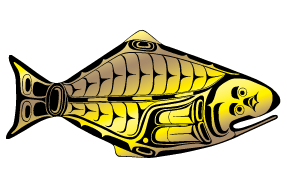22 February 2022
SEATTLE – The International Pacific Halibut Commission (IPHC) completed the 98th Session of the IPHC Annual Meeting (AM098) on 28 January 2022 with decisions on total mortality limits, fishing period dates, and other fishery regulation changes. A total of 172 individuals attended the meeting via the electronic platform, in addition to the delegations from Canada (12) and the United States of America (15).
Meeting documents, presentations and recordings of the sessions are available on the AM098 meeting page at the IPHC website: 98th Session of the IPHC Annual Meeting (AM098).
IPHC Media Release 2022-002 reported the initial results of AM098. Selected additional decisions of the 98th Session of the IPHC Annual Meeting (AM098) are highlighted below.
PACIFIC HALIBUT STOCK STATUS AND OUTLOOK
The Commission NOTED the following scientific advice from the IPHC Secretariat:
- “Sources of mortality: In 2021, total Pacific mortality due to fishing increased to 37.66 million pounds (17,084 t) but remained below the 5-year average of 38.48 million pounds (17,456 t). Of that total, 88% comprised the retained catch, up from 84% in 2020.”
- “Fishing intensity: The 2021 fishing mortality corresponded to a point estimate of SPR = 46%; there is a 47% chance that fishing intensity exceeded the IPHC’s current reference level of F43%. The Commission does not currently have a coastwide fishing intensity limit reference point.”
- “Stock status (spawning biomass): Current (beginning of 2022) female spawning biomass is estimated to be 191 million pounds (86,600 t), which corresponds to a 45% chance of being below the IPHC trigger reference point of SB30%, and less than a 1% chance of being below the IPHC limit reference point of SB20%. The stock is estimated to have declined by 17% since 2016 but is currently at 33% of the unfished state. Therefore, the stock is considered to be ‘not overfished’. Projections indicate that mortality consistent with the interim management procedure reference fishing intensity (F43%) is likely to result in further declining biomass levels in the near future.”
- “Stock distribution: The proportion of the coastwide stock represented by Biological Region 3 has increased sharply over 2020-21, reversing over a decade of steady decline. This trend occurs in tandem with declines in Biological Regions 2 and 4; however, all regions remain within the historical range observed from 1993-2021. These estimates have been updated and strongly informed by the comprehensive FISS design implemented in 2021.”
The Commission NOTED the following outlook for the stock provided by the IPHC Secretariat:
“Outlook. The projections for this assessment are more optimistic than those from the 2019 and 2020 assessments due to the increasing projected maturity of the 2012 year-class. This translates to a lower probability of stock decline for 2022 than in recent assessments as well as a decrease in this probability through 2023-24. There is greater than a 50% probability of stock decline in 2023 (55-64/100) for the entire range of SPR values from 40-46%, which include the status quo TCEY and the F43% reference level. The 2022 “3-year surplus” alternative, corresponds to a TCEY of 38.0 million pounds (~17,240 t), and a projected SPR of 48% (credible interval 32-63%). At the reference level (a projected SPR of 43%), the probability of spawning biomass decline from 2022 to 2023 is 59%, decreasing to 55% in three years, as the 2012 cohort matures. The one-year risk of the stock dropping below SB30% ranges from 43% at the F46% level to 45% at the at the F40% level of fishing intensity.”
IPHC PACIFIC HALIBUT FISHERY REGULATIONS 2022
The Commission approved a series of IPHC fishery regulation changes for 2022, including mortality limits and fishing periods. In accordance with the IPHC Convention1, the fishery regulations approved by the IPHC have been recommended to the Contracting Parties for implementation according to their domestic laws.
The IPHC Fishery Regulations (2022) approved by the Commission are available on the IPHC website(https://www.iphc.int/the-commission/fishery-regulations).
Mortality and Fishery Limits (Sect. 5)
The Commission ADOPTED the distributed mortality limits for each Contracting Party, by IPHC Regulatory Area and sector, as provided in Table 1.

The adopted mortality limits imply 6% increase with respect to 2021, as presented in Table 2.

Commercial fishing periods (Sect. 9)
The Commission ADOPTED fishing periods for 2021 as provided below, thereby superseding the relevant portions of Section 9 of the IPHC Pacific halibut fishery regulations by specifying that commercial fishing for Pacific halibut in all IPHC Regulatory Areas may begin no earlier than 6 March and must cease on 7 December.
This implies same fishing periods as in 2021.
Charter management measures in IPHC Regulatory Areas 2C and 3A (Sect. 29)
The Commission ADOPTED charter management measures for IPHC Regulatory Areas 2C and 3A for 2022:
- IPHC Regulatory Area 2C – one-fish bag limit with size limit of less than or equal to 40 inches or greater than or equal to 80 inches
- IPHC Regulatory Area 3A – two-fish bag limit with one fish of any size and a second fish less than or equal to 28 inches, Wednesdays and two Tuesdays (7/26 and 8/2) closed to retention of Pacific halibut, one trip per vessel, one trip per CHP per day, and no annual limit
- Recordkeeping requirements for annual limits (not applicable in 2022)
Trap gear use in IPHC Regulatory Area 2B (Sect. 18)
The Commission ADOPTED proposed IPHC Regulation changes to allow trap gear use on directed commercial trips in IPHC Regulatory Area 2B. The Commission also expressed interest in sharing experience between Contracting Parties on the effectiveness of the use of traps/pots in preventing whale depredation.
Fishery-Independent Setline Survey (FISS)
The Commission RECALLED the IM097 endorsement of the FISS design options for 2022 (Figures 1 and 2) and provisional endorsement of the designs for 2023 and 2024, and made no further amendments at AM098.
Figure 1. Endorsed optimized FISS design for 2022.

Figure 2. Alternative endorsed optimized FISS design for 2022.

Upcoming IPHC meetings
The Commission accepted the offer by Canada to host the 99th Session of the IPHC Annual Meeting (AM099) in 2023 in Victoria, BC, Canada from 23 to 27 January 2023.
Should the COVID-19 pandemic remain an issue at that time, the meeting may be held electronically.
The Commission will also hold electronically on 25th of February a Special Session (SS012) that will include the following agenda items: 1) FY2023 budget review and adoption; 2) Management Strategy Evaluation; 3) IPHC Fishery Regulations: Daily bag limit in IPHC Regulatory Area 2B (Sect. 28).
The Commission noted that it will be celebrating in 2024 its 100th Anniversary. Over the coming year, the Contracting Parties will collaborate to agree on any additional activities to be associated with the anniversary.
Officers of the Commission
The Commission elected Mr Paul Ryall (Canada) as Chairperson of the IPHC, and Mr Glenn Merrill (USA) as Vice-Chairperson of the IPHC.
IPHC Secretariat
International Pacific Halibut Commission
2320 W. Commodore Way, Suite 300
Seattle, WA 98199-1287
206-634-1838 | www.iphc.int
1The Convention between Canada and the United States of America for the Preservation of the [Pacific] Halibut Fishery of the Northern Pacific Ocean and Bering Sea.
2 “net weight” of a Pacific halibut means the weight of Pacific halibut that is without gills and entrails, head-off, washed (without ice and slime). If a Pacific halibut is weighed with the head on or with ice and slime, the required conversion factors for calculating net weight are a 2 percent deduction for ice and slime and a 10 percent deduction for the head.

